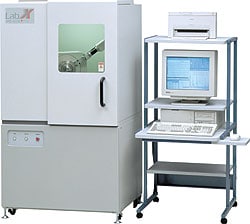Analysis of Semiconductor Photocatalyst crystallinity using X-ray diffractometers (XRD)
Semiconductor photocatalysts such as metal oxides and nitrides are identified, qualified, or their crystallinity evaluated using X-ray diffractometers (XRD).
XRD results show diffraction patterns that are plotted with diffraction angle on the horizontal axis and diffraction intensity on the vertical axis. Then these patterns are compared to the diffraction patterns for known substances for identification and qualification. However, because the sample surface shape can affect diffraction pattern results, sufficient sample quantity is generally required for powder samples, so that a flat surface can be formed for measurement.
However, polycapillary parallel beam optics system reduces such problems and enables high measurement sensitivity and precision even with small sample quantities.
In this example, multiple semiconductor photocatalysts were measured and compared.
Measurement Conditions
| Item | Polycapillary Optical System | Focused Beam Optical System |
| Instruments | XRD-7000 | XRD-7000 |
| Goniometer Radius | 200 mm | 200 mm |
| X-Ray Source | LFF Cu tube + polycapillary | LFF Cu tube |
| Tube Voltage/Current | 40 kV / 40 mA | 40 kV / 40 mA |
| Anti-Scattering Plate Height | 4 mm | None |
| Slit | None | DS 1 deg., SS 1 deg., RS 0.3 mm |
| Monochromator | Yes | Yes |
| Stage | Standard sample stand | Standard sample stand |
| Scan Range | 5 to 35 deg | 5 to 35 deg |
| Scan Step Size | 0.02 deg | 0.02 deg |
| Scan Speed | 2 deg/min | 2 deg/min |
| Integration Time | 0.6 sec/step | 0.6 sec/step |
Powder Sample on Non-Reflective Sample Plate
XRD was used to measure KCa2Nb3O10, which is a layered ion-exchange material comprising calcium niobate perovskite layers and potassium ion layers, used as a semiconductor photocatalyst.
5.6 mg of the powder sample was placed on the non-reflective sample plate for measurement.
Diffraction Pattern from Polycapillary and Focused Beam Optical Systems
Analytical Data
The figure shows results from using polycapillary and standard optics systems to measure KCa2Nb3O10 powder synthesized by baking at 1423 K for 10 hours using the SSR (solid state reaction) method. The polycapillary optics system resulted in about three times higher intensity levels than the standard optics system, where the error in 2θ due to sample status (height) is assumed to be small.
Diffraction Patterns for KCa2Nb3O10 Powder Samples Prepared Using Different Synthesis Parameters
The figure shows results from using the polycapillary optics system to measure KCa2Nb3O10 powder samples prepared using four different synthesis conditions.
At 823 K, the peaks are much broader than the other three samples, which indicates low crystallinity. Based on the measurement results for the samples synthesized using the PC (polymerized complex) method at 1123 K for 2 hours and at 1423 K for 2 hours, increasing the heating temperature resulted in a smaller FWHM value, which is presumably due to higher crystallinity. The results also showed a difference in FWHM between 1423 K 2-hour PC and 1423 K 10-hour SSR methods, which confirms that the differences in synthesis parameters affected crystallinity.
Sample source: Associate Professor Kazuhiko Maeda, Department of Chemistry, Graduate School of Science and Engineering, Tokyo Institute of Technology
XRD Polycapillary Optics System
Polycapillaries are multiple narrow glass tubes used to guide X-rays. These capillary tubes guide the X-rays emitted from a point-source at a very high solid angle into parallel beams at the output port on the opposite end.
Compared to a standard optics system (Bragg–Brentano method), this system utilizes the X-rays emitted from the X-ray tube more efficiently, which allows achieving higher diffracted X-ray intensities. Furthermore, because the optical system uses parallel beams, the diffraction angle remains unchanged even if the sample measurement surface shift positions.
Consequently, it resolves problems that standard optics systems can have with separation of diffracted rays or angle shifting and it allows measuring small quantities of powder samples without a flat surface or curved samples with high sensitivity and precision synthesis parameters affected crystallinity.



